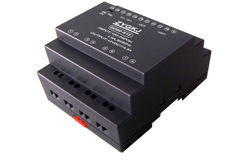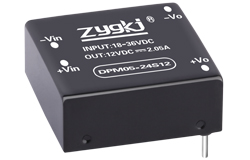বাতৰি
DC Power Conversion: Understanding the Basics and Applications
Author: ZYG Power Module Time: 2023-5-26
Direct current (DC) power conversion is an essential process in our modern world. It involves the transformation of electrical energy from one form to another. DC power conversion is widely used in various areas, from household appliances to industrial automation, and from renewable energy generation to electric vehicles. In this article, we will discuss the basics of DC power conversion and its applications.
DC Power Conversion Basics
DC power conversion involves three main components: input source, conversion circuit, and output load. The input source can be an AC power source, a battery, or a renewable energy source like solar or wind. The conversion circuit is responsible for converting the input power to the desired output power. It consists of voltage regulators, power converters, inverters, and transformers. The output load is the device or system that consumes the converted power.
DC power conversion can be classified into two types: AC to DC conversion and DC to DC conversion. AC to DC conversion involves the conversion of AC power to DC power. It is used in devices that require a steady DC voltage, such as computers, mobile phones, and LED lights. DC to DC conversion involves the conversion of DC power from one voltage level to another. It is used in devices that require different voltage levels, such as electric vehicles, solar energy systems, and industrial automation.
AC to DC Conversion
In AC to DC conversion, the AC power is converted to DC power using a rectifier circuit. The rectifier circuit consists of diodes that allow the current to flow in only one direction. The rectifier circuit can be either a half-wave rectifier or a full-wave rectifier.
A half-wave rectifier allows only half of the AC input cycle to pass through, resulting in a pulsating DC output. A full-wave rectifier allows both halves of the AC input cycle to pass through, resulting in a smoother DC output. The rectified output voltage can be further smoothed by using a capacitor filter.
DC to DC Conversion
In DC to DC conversion, the input voltage is transformed to the desired output voltage using a converter circuit. The converter circuit can be either a buck converter or a boost converter.
A buck converter reduces the input voltage to a lower output voltage by using a switch and an inductor. The switch is turned on and off at a high frequency, creating a ripple current in the inductor. The inductor stores the energy during the on-time and releases it during the off-time, resulting in a lower output voltage.
A boost converter increases the input voltage to a higher output voltage by using a switch, an inductor, and a diode. The switch is turned on and off at a high frequency, creating a ripple current in the inductor. The diode prevents the inductor from discharging back to the input during the off-time, resulting in a higher output voltage.

DC Power Conversion Applications
DC power conversion is used in various applications, including:
1. Renewable Energy Systems: DC power conversion is used to transform the DC power generated from renewable energy sources like solar and wind to AC power for grid connection.
2. Electric Vehicles: DC power conversion is used to convert the DC power from the battery to the desired voltage level for the motor.
3. Industrial Automation: DC power conversion is used to convert the DC power to various voltage levels for the control systems in factories.
4. Household Appliances: DC power conversion is used to power various household appliances like computers, mobile phones, and LED lights.
Conclusion
DC power conversion is an essential process in our modern world. It involves the transformation of electrical energy from one form to another using various conversion circuits. DC power conversion is used in various applications, from renewable energy systems to electric vehicles and household appliances. Understanding the basics of DC power conversion is crucial for designing efficient and reliable systems in these applications.
পূৰ্ৱবৰ্তী: Efficient and Reliable ACDC Power Supply SF Series (3~100W)
এটাৰ পাচৰ: Efficient Power Conversion with ACDC Converter SPM Series (30-300W)
প্ৰাসংগিক তথ্য
-
2023-4-13
AC-DC Converter: Converting Alternating to Direct Current
AC-DC Converter: Converting Alternating to Direct Current An AC-DC converter is an electronic device that is used to convert alternating current (AC) to direct current (DC). The use of these converters is widespread, and they can be found in many different applications, including power supplies for electronic devices, motor control systems, and battery chargers. The primary advantage of using an AC-DC converter is that it allows electrical devices to be powered using direct current, which is the preferred method of powering most electronic devices. Direct current provides a constant level of voltage and is less likely to cause interference or damage to electronic devices than alternating current. The conversion process involves several steps. The first step is to rectify the...
সবিশেষ চাওক -
2023-7-8
Introducing the DM Series DC Power Supply
In today's technologically advanced world, the demand for efficient and reliable power supply solutions has never been higher. Whether it is for industrial applications, research laboratories, or educational institutions, having a high-quality DC power supply is essential. That is why we are proud to introduce the DM Series DC Power Supply. With its cutting-edge features and industry-leading performance, this power supply is set to revolutionize the way you power your devices. One of the standout features of the DM Series DC Power Supply is its versatility. It is designed to meet the needs of a wide range of applications, making it the perfect choice for professionals from various industries. Whether you are working on electronics, telecommunications, or even automotive projects,...
সবিশেষ চাওক -
2023-12-27
High Voltage Power Supply Module: Delivering Power with Precision
The high voltage power supply module is an essential component in various industries and applications, ranging from scientific research to medical equipment. This module plays a crucial role in delivering power with precision, ensuring the efficient and reliable operation of devices that require high voltage levels. In this article, we will explore the working principle, key features, and applications of the high voltage power supply module. Working Principle: The high voltage power supply module operates on the principle of voltage transformation and regulation. It consists of several components, including a transformer, rectifier, and voltage regulator. The transformer converts the input voltage to a higher level, while the rectifier converts the alternating current (AC) into direct current (DC). The voltage regulator...
সবিশেষ চাওক -
2023-8-5
AC/DC Power Supply Module: Providing Reliable Electrical Power for Various Applications
Introduction In the modern world, reliable electrical power is essential for the smooth functioning of various applications. From electronic devices to industrial machinery, a stable power supply is crucial to ensure optimal performance and prevent damage due to voltage fluctuations. This is where the AC/DC Power Supply Module comes into play. Designed with precision and efficiency in mind, this module is a reliable solution for meeting the power requirements of diverse applications. Understanding the AC/DC Power Supply Module The AC/DC Power Supply Module is a compact electronic device that converts the alternating current (AC) power from a wall outlet into direct current (DC) power suitable for powering electronic components. It operates on the principle of electromagnetic induction and employs various...
সবিশেষ চাওক -
2023-4-13
Generating AC-DC Conversion with Efficiency and Reliability
Generating AC-DC conversion is a process of converting alternating current (AC) into direct current (DC) for use in various electronic devices. The process involves the use of power electronic circuits and devices that provide reliable and efficient power conversion. In this article, we will discuss the importance of generating AC-DC conversion with efficiency and reliability. Efficient power conversion is critical in electronic devices as it ensures that the power is used optimally, and there is minimal energy loss. This translates to reduced energy costs and increased device performance. The conversion process should be designed to minimize power loss and to achieve high efficiency. Reliability is also a crucial aspect of power conversion. Electronic devices rely on a constant and reliable...
সবিশেষ চাওক -
2023-6-9
Bidirectional DC-DC Converter: A Guide for Power Conversion in Both Directions
Introduction The bidirectional DC-DC converter is a power electronic device used to convert DC power from one voltage level to another in both directions. These converters are used in various applications, such as battery energy storage systems, electric vehicles, renewable energy systems, and many more. This article will discuss the working principle, types, and applications of the bidirectional DC-DC converter. Working Principle The bidirectional DC-DC converter is based on the principles of pulse-width modulation (PWM) and power electronics. It consists of two power switches, a control circuit, and an isolation transformer. The control circuit generates the pulse signals and controls the switching of the power switches, which in turn controls the output voltage. When power is flowing from the input...
সবিশেষ চাওক


















